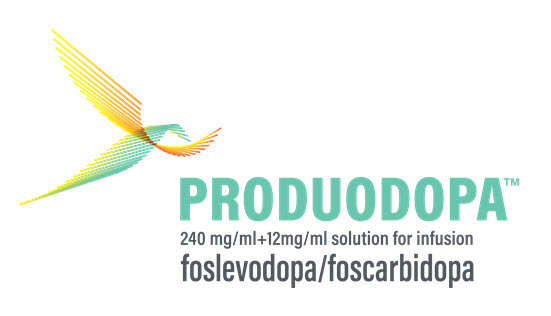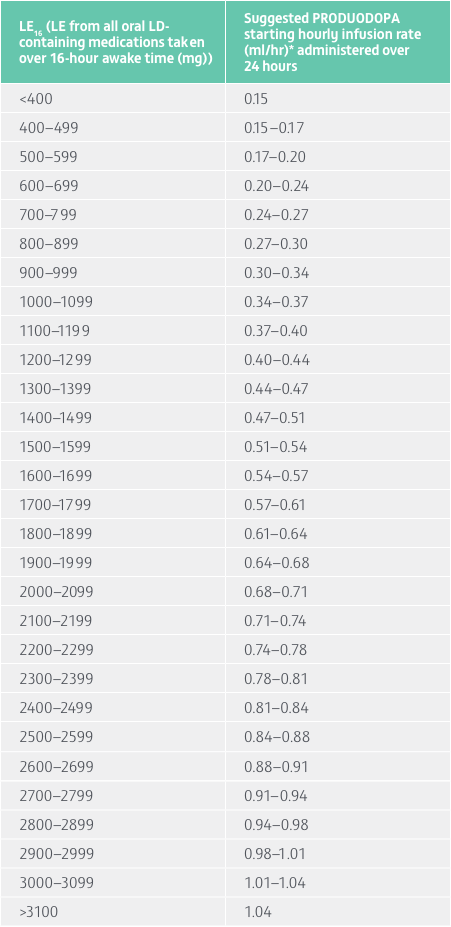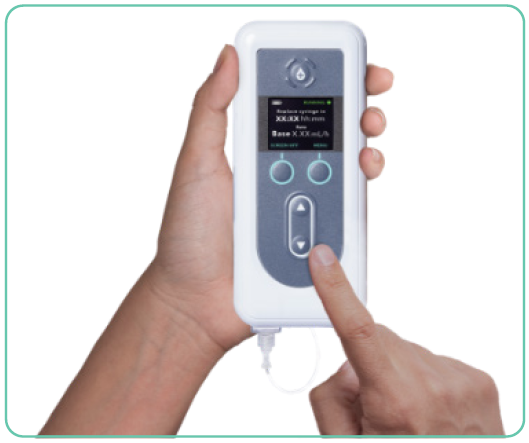This promotional material is intended for UK Healthcare Professionals (HCPs) experienced in the diagnosis and management of Parkinson’s disease only. Adverse event reporting can be found below
Some patients may not be suitable for PRODUODOPA. You are strongly advised to read the Prescribing information (PI), and Summary of Product Characteristics (SmPC) which can be found via the links above, to evaluate patient suitability for PRODUODOPA.
Initiating treatment1
- PRODUODOPA is administered as a continuous subcutaneous infusion, 24 hours per day
- The recommended starting infusion rate of PRODUODOPA is determined by converting the daytime levodopa intake to levodopa equivalents (LE) and then increasing it to account for a 24-hour administration
- The dose may be adjusted to reach a clinical response that maximises the functional ‘On’ time and minimises the number and duration of ‘Off’ episodes and ‘On’ episodes with troublesome dyskinesia
- The maximum recommended daily dose of foslevodopa is 6,000 mg (or 25 ml of PRODUODOPA per day equivalent to approximately 4,260 mg levodopa per day)
- PRODUODOPA replaces levodopa-containing medications and catechol-O-methyl transferase (COMT)-inhibitors. If required, other classes of medicinal products for Parkinson’s disease can be taken concurrently
Contraindications1
PRODUODOPA is contraindicated in patients with:
- Hypersensitivity to the active substances or to any of the excipients
- Narrow-angle glaucoma
- Severe heart failure
- Acute stroke
- Severe cardiac arrhythmia
- Non-selective MAO inhibitors and selective MAO type A inhibitors are contraindicated for use with PRODUODOPA.
These inhibitors must be discontinued at least two weeks prior to initiating therapy with PRODUODOPA. PRODUODOPA may be administered concomitantly with the manufacturer’s recommended dose of a MAO inhibitor with selectivity for MAO type B (e.g., selegiline HCl)
- Conditions in which medication with adrenergic activity are contraindicated, e.g., pheochromocytoma, hyperthyroidism and Cushing’s syndrome
Because levodopa may activate malignant melanoma, PRODUODOPA should not be used in patients with suspicious undiagnosed skin lesions or a history of melanoma.
Patients selected for treatment with PRODUODOPA should be capable of understanding and using the delivery system themselves or with assistance from a caregiver. Patients should be trained on the proper use of PRODUODOPA and the delivery system prior to initiating treatment with PRODUODOPA and, as necessary, thereafter.1
See SmPC for special warnings and precautions for use and full information.
The levodopa amount from all levodopa-containing formulations used during the awake time of the day (typically 16-hour/day) should be converted to LE using the appropriate dose multiplication factor from the table below and then summed. For this calculation, only consider levodopa and COMT inhibitors. Do not include rescue levodopa or any other anti-Parkinsonian medication or therapy, including medications taken outside of awake time (e.g., night-time dosing) in this calculation. If any COMT inhibitors are taken within a 24-hour period, regardless of the COMT inhibitor dose, a correction factor should be applied to the sum of LE as presented in Table below.
Calculating the levodopa equivalents (LE)
| Levodopa formulation | Dose multiplication factor |
Immediate-release, including enteral suspension | 1 |
Sustained-release, controlled-release or prolonged-release* | 0.75 |
| If any COMT inhibitor is used, multiply sum of calculated LE from above by 1.33* | |
*The levodopa contained in combined LD/CD/COMT-inhibitor formulations count as immediate release and needs to be added to the LE from all other sources of levodopa before the sum is multiplied for the COMT-inhibitors correction factor (i.e., do not apply COMT correction factor to single LE).
CD=carbidopa; LD=levodopa; COMT=catechol-O-methyl transferase; LE=levodopa equivalents.
Refer to table below for suggested PRODUODOPA starting infusion rates based on the LE calculated in Step 1.
The hourly infusion rate for PRODUODOPA in Table below is based on a patient’s LE intake during a typical 16-hour awake time (LE16).
If the LE determined in Step 1 were based on an awake time either longer or shorter than 16 hours, the LE should be adjusted to a 16-hour period. To adjust to a 16-hour period, take the LE calculated in Step 1, divide by the number of hours the patient is typically awake, and then multiply by 16. Then refer to table below for PRODUODOPA suggested starting infusion rates. An alternative is to calculate the starting hourly infusion rate according to the formula given under the table below, where X is the number of patient's awake hours/day.
The hourly infusion rate determined in this step should be entered as the Base infusion rate when programming the pump (refer to the pump instructions for use for details).
*The hourly infusion rate can be calculated using the following formula, where X is the number of patient’s awake hours used to determine the Levodopa Equivalents (LE) (e.g. X=16, in the table above).
Hourly infusion rate (ml/hr) = [(LE · 0.92 · 1.41) ⁄ 240] ⁄ X
Assumptions used to generate the “Suggested PRODUODOPA starting hourly infusion rate”:
• Total daily LE over 16 hours are increased by 50% to account for 24-hour dosing
• Subcutaneous foslevodopa is 8% more bioavailable than enterally absorbed levodopa
• The molecular weight ratio between foslevodopa and levodopa is 1.41:1
• One millilitre of PRODUODOPA contains 240 mg of foslevodopa and 12 mg of foscarbidopa
• Most patients with PD are treated with oral PD medications during their waking time (typically 16-hour/day treatment period); once the amount of foslevodopa needed over the 16-hour period has been calculated, it is divided by 240 mg to determine the number of millilitres needed over the 16-hour period, and then divided over 16 hours to establish the hourly infusion rate.
LE=levodopa equivalents; LD=levodopa; PD=Parkinson’s disease.
A loading dose can be administered immediately prior to commencing the hourly infusion to quickly achieve symptomatic control when starting PRODUODOPA therapy in an “Off” state (or if the pump has been off for more than 3 hours). Loading doses can be administered either via the pump or using oral immediate-release carbidopa-levodopa tablets.
Table below provides the recommended loading dose volume (ml) of PRODUODOPA to be programmed into the pump (refer to the pump instructions for use for details) and the corresponding amount of immediate-release levodopa (mg), regardless of the peripheral inhibitor of the DOPA decarboxylase (e.g., carbidopa, benserazide) co-administered.
Determination of PRODUODOPA volume recommended for the loading dose
| Recommended loading dose volume (ml) to be programmed into the pump | Approximate corresponding levodopa amount (mg) |
0.6 | 100 |
0.9–1.2 | 150–200 |
1.5–1.8 | 250–300 |
2.0 | 350 |
0.1 ml of PRODUODOPA contains 24 mg foslevodopa (equivalent to approximately 17 mg of levodopa). The pump is capable of delivering a loading dose ranging from 0.1 ml to a maximum of 3.0 ml, in increments of 0.1 ml.
Please refer to the PRODUODOPA Summary of Product Characteristics (SmPC) and Vyafuser pump Instructions for Use for full dosing and administration information.
Optimisation and maintenance of dosing1
PRODUODOPA can be taken alone or, if necessary, with other concurrent medicinal products for Parkinson’s disease, based on the judgement of the healthcare professional. A reduction in other concomitant medications for Parkinson’s disease, followed by an adjustment in PRODUODOPA dosage, may be considered during PRODUODOPA infusion. The concomitant use of PRODUODOPA with other levodopa-containing medications or with medicinal products that significantly regulate synaptic dopamine levels (such as COMT inhibitors) has not been studied.1
Method of administration1
PRODUODOPA is administered subcutaneously, preferably in the abdomen, avoiding a 5-cm radius area from the navel. Use aseptic technique when preparing and administering PRODUODOPA.
Infusion set and site management
- The infusion set (cannula) can remain in place for up to 3 days when the medication is infused continuously. Rotate the infusion site and use a new infusion set at least every 3 days
- It is recommended that new infusion sites be at least 2.5 cm from sites used within the previous 12 days
- PRODUODOPA should not be infused into areas where the site is tender, bruised, red, or hard to the touch
For administration of PRODUODOPA only the Vyafuser pump should be used (refer to the pump instructions for use for details) using sterile, single-use infusion components (syringe, infusion set, and vial adapter) qualified for use. Patients should be trained on the proper use of PRODUODOPA and the delivery system (pump, solution vial, vial adapter, syringe, infusion set, carrying accessory, rechargeable battery, and charger) prior to initiating treatment with PRODUODOPA and, as necessary, there after.
Storage1
The medication should be stored and transported refrigerated (2°C–8°C). Do not freeze.
Keep the vials in the outer carton to protect the vials from breaking.
May be stored at room temperature up to a maximum of 30°C for a single period of up to 28 days. Once a vial has been stored at room temperature, do not return the product to the refrigerator. Record the date when PRODUODOPA is first removed from the refrigerator in the space provided on the carton.
For storage conditions after first opening of the medicinal product, see section 6.3 Shelf life in the SmPC.
The medicine should be at room temperature prior to infusion. If refrigerated prior to use, the vial should be removed from the refrigerator and allowed to sit at room temperature out of direct sunlight for 30 minutes. If refrigerated the medicine must not be warmed (in the vial or syringe) in any way other than letting it warm at room temperature. For example, it must not be warmed in a microwave or in hot water.
Special precautions for storage
The medication vials are for single use only. Once the content of a vial is transferred into the syringe, the contents of the syringe should be administered within 24 hours. Used medication vials and syringes should be discarded according to local regulations. Syringes must be discarded, even if residual product remains, as instructed by the healthcare professional (see section 6.6 Special precautions for disposal in the SmPC).
Interruption of therapy1
Sudden discontinuation or rapid dose reduction of PRODUODOPA, without administration of alternative dopaminergic therapy, should be generally avoided.
PRODUODOPA can be interrupted without further actions for brief periods of time, such as when the patient is taking a shower.
For interruptions longer than 1 hour, a new infusion set (tubing and cannula) should be used and rotated to a different infusion site.
If the infusion has been interrupted for longer than 3 hours, the patient may also self-administer a loading dose, if enabled by their healthcare professional, to quickly re-establish symptom control.
If treatment with PRODUODOPA is interrupted for a prolonged time (>24 hours) or permanently discontinued, the healthcare professional should determine appropriate alternative dopaminergic treatment (e.g., oral levodopa/carbidopa). Treatment with PRODUODOPA may be resumed at any time following instructions as for initiation of PRODUODOPA.
Special populations1
The pharmacokinetics of PRODUODOPA has not been evaluated in any special population. PRODUODOPA is intended for use in Parkinson’s disease patients who are already on a stable dose of oral levodopa. Differences in exposure are not considered clinically significant because PRODUODOPA is optimised once patients begin therapy. Therefore, covariate effects are not expected to impact clinical efficacy or safety.
Elderly
The impact of age on the levodopa pharmacokinetics following PRODUODOPA infusion was not specifically evaluated. Studies with levodopa suggest a modest reduction of levodopa clearance with increasing age.
Renal or hepatic impairment
The pharmacokinetics of PRODUODOPA in subjects with renal and/or hepatic impairment has not been established.
The anticipated daily phosphorus load from the highest proposed clinical dose of foslevodopa/foscarbidopa (6000/300 mg/day of foslevodopa/foscarbidopa) is approximately 700 mg, which is considerably less than the United States National Academy of Sciences dietary reference intake upper limit of 3000 mg/day; however, there are no pharmacokinetic or safety data with PRODUODOPA in patients with End Stage Renal Disease requiring dialysis. Therefore, caution should be exercised in patients with End Stage Renal Disease on dialysis requiring treatment with PRODUODOPA because of diminished ability of the kidneys to eliminate phosphate.
Body weight
The impact of body weight on the levodopa pharmacokinetics following PRODUODOPA infusion was not specifically evaluated. Previous studies of levodopa have shown that weight increases volume of distribution and can lower levodopa exposure.
Gender or race
Following PRODUODOPA administration, carbidopa and levodopa exposures in both Japanese subjects and Han Chinese subjects were comparable to those in Caucasian subjects.
The impact of gender on the pharmacokinetics following PRODUODOPA infusion was not specifically evaluated. The effect of gender on the pharmacokinetics of levodopa has been evaluated and studies suggested there is no clinically meaningful gender-related difference in levodopa exposure.
Following PRODUODOPA dosing, levodopa exposure was higher in females once weight was considered by approximately 18% based on AUC.
Please refer to the PRODUODPA Summary of Product Characteristics (SmPC) for more information on the pharmacokinetics of levodopa and carbidopa in special populations.
PRODUODOPA can be taken as a monotherapy1
Please refer to the PRODUODOPA Summary of Product Characteristics (SmPC) and Vyafuser pump Instructions for Use for full dosing and administration information. Please refer to the PRODUODOPA SmPC for further information on adverse events, contraindications and special warnings, special populations, storage and precautions for disposal and precautions for use.
References
- PRODUODOPA (foslevodopa/foscarbidopa solution for infusion) Summary of Product Characteristics.
- Healthcare Professional Instruction for Use of VYAFUSERTM Pump Version: Sept. 2023, GBR Ver 1.0.
By clicking the link above you will leave the AbbVie Pro website and be taken to the eMC PI portal website
Adverse events should be reported. Reporting forms and information can be found at yellowcard.mhra.gov.uk.
Adverse events should also be reported to AbbVie on GBPV@abbvie.com
UK-PRODD-240201. Date of preparation: December 2024.












